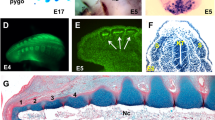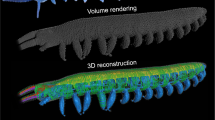Abstract
Two longitudinal vertebral ligaments occur in most fishes, for example, haddock1, one dorsal to the nerve cord in the neural arch, and one ventral to the nerve cord above the centra—though the latter is not always well developed.
Similar content being viewed by others
Article PDF
References
Farugi, A. J., Proc. Zool. Soc., 313 (1935).
Burne, N., Proc. Zool. Soc., 201 (1909).
Franz, K., Morph. Jahrb., 25, 143 (1898).
Ramanujam, S. M., Proc. Zool. Soc., 365 (1929).
Author information
Authors and Affiliations
Rights and permissions
About this article
Cite this article
DE KOCK, L., SYMMONS, S. A Ligament in the Dorsal Aorta of Certain Fishes. Nature 184, 194 (1959). https://doi.org/10.1038/184194a0
Issue Date:
DOI: https://doi.org/10.1038/184194a0
Comments
By submitting a comment you agree to abide by our Terms and Community Guidelines. If you find something abusive or that does not comply with our terms or guidelines please flag it as inappropriate.



